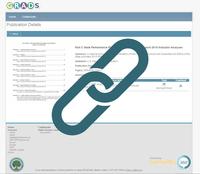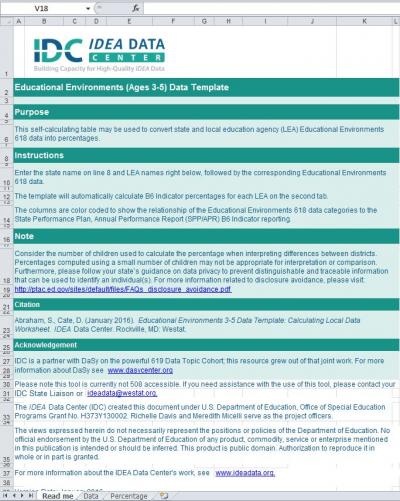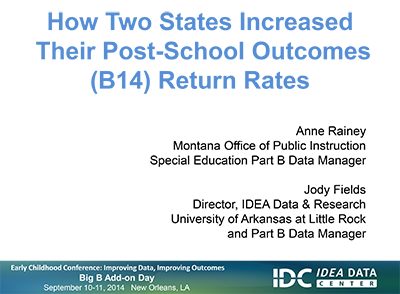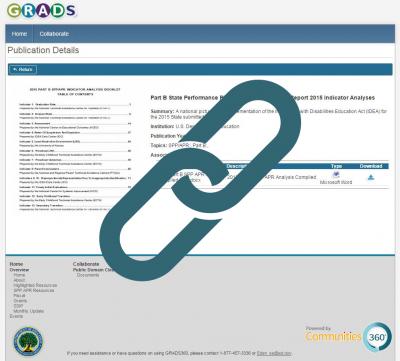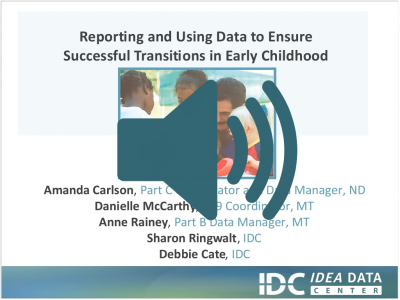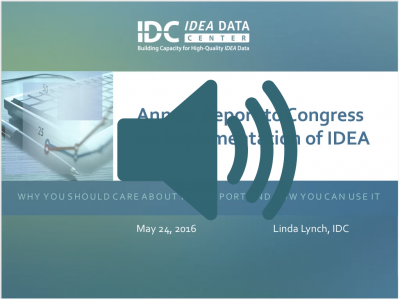Site Search
Results 1 - 7 of 25
Format: Guides, Papers, and Reports
Part B State Performance Plan/Annual Performance Report 2014 Indicator Analysis FFY 2012-13The report presents a national quantitative picture of the implementation of Part B of IDEA based on a review of FFY 2012 APRs for the 50 states, commonwealths, territories, and the BIE.
Format: Guides, Papers, and Reports
Part C State Performance Plan/Annual Performance Report 2015 Indicator AnalysesThe 2015 SPP/APR Indicator Analyses for Part C presents a national quantitative picture of the implementation of Part C of IDEA based on a review of information 56 states and jurisdictions reported in their FFY 2013 Annual APRs. For the purposes of the report, the term “state” is used for both states and territories. The report, which covers Part C Indicators 1 through 11, can be downloaded in Word format.
Format: Toolkits and Templates
Educational Environments 3-5 Data Template: Calculating Local Data WorksheetThis data template provides SEAs and LEAs the opportunity to see in real-time the percentages of their children ages 3-5 attending and receiving services in specific educational environments. When the LEA 618 educational environments data is simply entered on the data tab, the percentages will be calculated and displayed on the percentage tab. The use of this tool will allow SEAs to compare the percentages of children within educational environments across LEAs.
Format: Presentations
How Two States Increased Their Post-School Outcomes (B14) Return RatesMontana and Arkansas Part B Data Managers presented how they conduct their post-school outcomes (Indicator B14) surveys and how they have been able to increase their response rates over four years. They discussed what has worked for them, what they have learned along the way, and how they can now use these data as a part of their SSIP analysis.
Format: Guides, Papers, and Reports
Part B State Performance Plan/Annual Performance Report 2015 Indicator AnalysesThe 2015 SPP/APR Indicator Analyses for Part B presents a national quantitative picture of the implementation of Part B of IDEA based on a review of information 60 states and jurisdictions reported in their FFY 2013 Annual APRs. For the purposes of the report, the term “state” is used for both states and territories. The report, which covers Part B Indicators 1 through 17, can be downloaded in Word format.
Format: Recordings
Reporting and Using Data to Ensure Successful Transitions in Early Childhood WebinarThis webinar highlighted the IDEA state reporting requirements for early childhood transitions for both Part C and Part B, found in the SPP/APR Part C Indicator 8 and Part B Indicators 11 and 12. Participants shared resources related to transition, data collection, and reporting, as well as the use of both Part C and Part B data to facilitate high quality transitions. North Dakota's Part C coordinator and data manager and Montana's 619 coordinator and data manager described how their states collect and use transition data to ensure smooth transitions for all young children as they turn three and move from early intervention services to preschool 619 services.
Format: Recordings
Annual Report to Congress on Implementation of IDEA WebinarThe webinar featured the purpose and history of the Annual Report to Congress on the Implementation of the Individuals with Disabilities Education Act, its current organization and content, links to the report and its data sources, and suggestions for how participants can use the report. The webinar was designed so that participants would have a greater understanding of why it is important to work to improve the quality of IDEA-related data by seeing how the U.S. Department of Education uses IDEA data to meet an annual statutory requirement to report to Congress;. In addition, it was designed to help participants become familiar with a key resource on state and national IDEA data and related information and prompt them to think about how they might use the resource.


